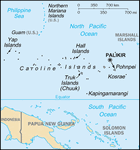Browse All Micronesian Recipes: Micronesian Appetizers | Micronesian Soups | Micronesian Salads | Micronesian Vegetarian | Micronesian Meat Dishes | Micronesian Snacks | Micronesian Desserts
Overview of Micronesian Cuisine History[]
Micronesia means « small islands » and is it composed of 2,100 tropical islands scaterred across the middle of the Pacific Ocean between Hawaii and the Philippines. Each island has its own culture and topographical personality. As far as food is concerned, in the Federated states of Micronesia you can find tempting and delectable delicacies. In fact, Micronesia is nothing but a unique combination of western and eastern cuisine. For instance, the main influences come from Spanish, Malay and Chinese cultures. For the inhabitants of these islands, food is so important, that it is perceived as an integral part of local culture and art and also an essential body of the communal existence. In this area, Micronesian chefs do not use hot chilies in preparing different dishes, therefore, the Macronesian cuisine can be characterised as being mild.
Cuisines of Micronesia[]

Map of Micronesia- Click to enlarge
Like in most Asian countries, the most important dish is rice which is generally served with most meals. A very simple dish is that prepared with fish of different sizes from the sea. Micronesian food is also based on fish and seafood, such as fresh shellfish, crabs, and shrimps. In addition to these dishes, in the Federated States of Micronesia, people use sauces and spices. Seafood is very tasty when it is left uncooked in a vinaigrette matrix, grilled, and even stuffed with onions wrapped in banana leaves. Exotic Micronesian dishes contain coconut and coconut milk that are great in cooking meat and vegetable dishes. Also, coconuts are used in creating mouth-watering desserts like bibingka or pudding made of rice, coconut milk, Sugar and eggs, and macapuno or thick dessert jam.
Preparation Methods for Micronesian Cooking[]
Micronesian cuisine uses elements from various cooking traditions borrowed from their neighbours and developed from their own traditional dishes. While there are no specific or unique preparation methods for Micronesian cooking, we should point out that attention to detail is important in the Micronesian cuisine. Using the right amount of spices for example is essential - either for spicing up the taste or for coloring the dish. The diversity of vegetables and cereals found in Micronesia is also noticed in the delicious dishes belonging to their cuisine. The visual attractiveness of the dish is also important, and a balance between colors and proportion differentiates. Each traditional dish has a special cooking method, which is more or less general in all of Micronesia's regions. Meat is one of the main elements of most Micronesian dishes and cured and smoked hams are often parts of delicious dishes.
Special Equipment for Micronesian Cooking[]
Ranging from cake pans, can openers, colanders, egg rings, poachers and holders, food dishers & portioners, food pans & food containers to other kitchen utensils, such as food scales, food scoops and fryer baskets & accessories, the Micronesian cuisine needs a diverse cooking equipment set in order to produce the most sophisticated Micronesian dishes. You should consider insulated food carriers if you are transporting the food and a full set of kitchen linens and uniforms if you wish to look like a pro. Here are a few other items that will come handy while cooking Micronesian food: juicers, kitchen knives, kitchen slicers, kitchen thermometers, measuring cups & measuring spoons, miscellaneous utensils, mixing bowls and skimmers & strainers. Essential utensils like serving spoons, spatulas, forks, turners, scrapers and tongs should also be part of your cooking "arsenal".
Micronesian Food Traditions and Festivals[]
The most important Micronesian festival is represented by Yap Day Festival, a celebration of cultures, dance and traditional costumes held in a different village every year. This villages hold the « mit-mit », hosting the event and providing free traditional and western food and drink. Dance is another important part of this festival and it includes sitting dances, standing dances, kneeling dances, and stick dances. On this special occasion, everybody dresses in colourful traditional costumes and crowds all gather to witness the performance of every village. Held on the first weekend of March, the Yap Day Festival can also be perceived as a form of competition between villages. As a symbol of friendship, hospitality and respect, people have different types of dishes, such as rice, meat, fresh meat, or seafood, but it is essential to have national dishes like lumpia, adobo, sinigang, bistek, and lechon.
